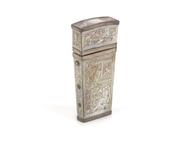











Pewter bleeding bowl, graduated, 18th or 19th century
Imagine it’s the 1860s and you are lying ill in bed. You feel absolutely awful, with a high fever and a raging temperature. Unable to eat, you are getting steadily weaker. Fortunately your family can afford a doctor and he eventually arrives. After assessing your condition he reaches into his bag, but instead of a soothing medicine he takes out a small, sharp lancet and a metal bowl like this one. Grasping your forearm he cuts into a prominent vein and your blood flows freely into the bowl. Just six fluid ounces this time – but with more to come in a few hours if your condition doesn’t improve. You’re pretty delirious, but isn’t this ‘treatment’ likely to make your condition even worse?
Almost certainly, yes. But until well into the 1800s, your doctor is quite likely to have bled you for – in his mind – pretty sound reasons. It was a standard medical practice routinely carried out for many hundreds of years and a technique very familiar to Ancient Egyptian, Greek, Roman and Islamic civilisations. Because when your medical beliefs are firmly based around a theory of humours, where ill health is due to an imbalance in the four humours – phlegm, yellow bile, black bile and blood – then bloodletting seems perfectly logical. It was a means of adjusting one of the fours humours to a proper balance.
Even as humoral theory was being discarded, the practice continued. It remained a treatment for a wide range of conditions with physicians giving various justifications for its use. Amongst other benefits it was said to reduce inflammation, help relieve pressure on the heart and bring down a strong fever. So, even a well educated mid-Victorian doctor wouldn’t want to attend a sick patient without a lancet and his trusty, bleeding, bowl.
Details
- Category:
- Therapeutics
- Collection:
- Sir Henry Wellcome's Museum Collection
- Object Number:
- A43201
- Materials:
- whole, pewter
- type:
- bleeding bowl




